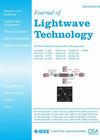Wide-Range and Sensitivity-Tunable Optical Fiber Microstructures for High-Temperature Detection System
IF 4.8
1区 工程技术
Q2 ENGINEERING, ELECTRICAL & ELECTRONIC
引用次数: 0
Abstract
We propose fiber microstructures based on the dispersion-compensated fiber (DCF) for industrial high- temperature detection (1000 °C). The single mode fiber - dispersion compensated fiber - single mode fiber (SDS) sensor achieves a temperature sensitivity of 47.35 pm/°C in the range of 30–110 °C, which is four times greater than that of a typical fiber Bragg grating (10 pm/°C). The single mode fiber - dispersion compensated fiber (SD) sensor based on the Michelson interference (MI) principle is fabricated by splicing a DCF at the end of a single mode fiber (SMF), which effectively suppresses multimode interference and attenuates interference peaks using Fresnel reflection. The sensitivities of the SD fiber sensors with DCF lengths of 7 mm, 8 mm and 9 mm are 62.38 pm/°C, 53.45 pm/°C and 51.25 pm/°C, respectively, in the temperature range of 30–200 °C, and the free spectral range (FSR) of the interference spectra decreases with increasing DCF length. After high-temperature annealing of the fiber microstructures, the internal stress of the DCF can be effectively released, which improves the dispersion compensation performance and reduces the transmission loss. We select SD fiber sensors with a DCF length of 7 mm for high-temperature annealing and then repeat the high-temperature experiments over a wide range of 30–800 °C, and the interference spectra all show consistent redshifts. The temperature sensitivity in the range of 500–800 °C is as high as 106 pm/°C. The refractive index difference between the DCF core and cladding changes as the temperature increases from 800–1000 °C, and the redshift trend of the interference spectrum with increasing temperature is reversed to a blueshift at 920 °C. This sensor, characterized by a wide temperature range, adjustable sensitivity and good repeatability and stability in high-temperature environments, has significant application potential in industrial production.用于高温检测系统的宽量程和灵敏度可调光纤微结构
我们提出了基于色散补偿光纤(DCF)的光纤微结构,用于工业高温检测(1000°C)。单模光纤-色散补偿光纤-单模光纤(SDS)传感器在30-110°C范围内的温度灵敏度为47.35 pm/°C,是典型光纤布拉格光栅(10 pm/°C)的4倍。基于迈克尔逊干涉(MI)原理,在单模光纤(SMF)末端拼接DCF制成单模光纤色散补偿光纤(SD)传感器,该传感器能有效抑制多模干涉,并利用菲涅耳反射衰减干涉峰。在30 ~ 200℃温度范围内,DCF长度为7 mm、8 mm和9 mm的SD光纤传感器的灵敏度分别为62.38 pm/°C、53.45 pm/°C和51.25 pm/°C,干扰光谱的自由光谱范围(FSR)随DCF长度的增加而减小。光纤微结构经过高温退火后,DCF的内应力得到有效释放,提高了色散补偿性能,降低了传输损耗。我们选择DCF长度为7 mm的SD光纤传感器进行高温退火,然后在30-800°C的大范围内重复高温实验,干涉光谱都显示出一致的红移。温度灵敏度在500 ~ 800℃范围内高达106 pm/℃。在800 ~ 1000℃范围内,DCF芯与包层之间的折射率差随温度的升高而变化,在920℃时,干涉光谱随温度升高的红移趋势逆转为蓝移。该传感器具有温度范围宽、灵敏度可调、在高温环境下重复性和稳定性好等特点,在工业生产中具有重要的应用潜力。
本文章由计算机程序翻译,如有差异,请以英文原文为准。
求助全文
约1分钟内获得全文
求助全文
来源期刊

Journal of Lightwave Technology
工程技术-工程:电子与电气
CiteScore
9.40
自引率
14.90%
发文量
936
审稿时长
3.9 months
期刊介绍:
The Journal of Lightwave Technology is comprised of original contributions, both regular papers and letters, covering work in all aspects of optical guided-wave science, technology, and engineering. Manuscripts are solicited which report original theoretical and/or experimental results which advance the technological base of guided-wave technology. Tutorial and review papers are by invitation only. Topics of interest include the following: fiber and cable technologies, active and passive guided-wave componentry (light sources, detectors, repeaters, switches, fiber sensors, etc.); integrated optics and optoelectronics; and systems, subsystems, new applications and unique field trials. System oriented manuscripts should be concerned with systems which perform a function not previously available, out-perform previously established systems, or represent enhancements in the state of the art in general.
 求助内容:
求助内容: 应助结果提醒方式:
应助结果提醒方式:


